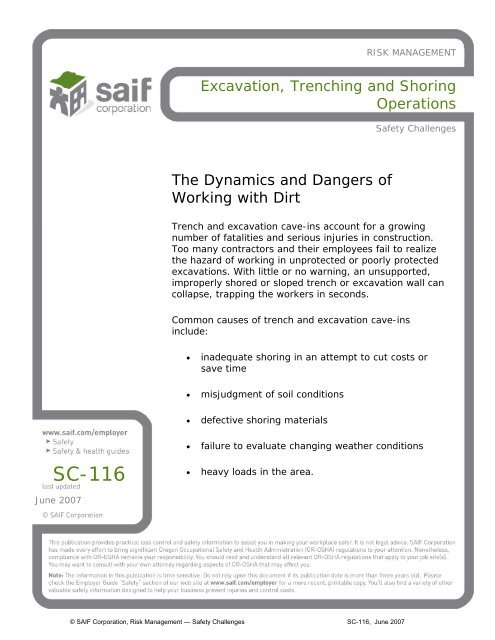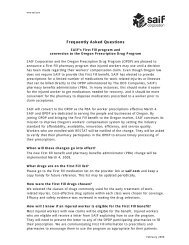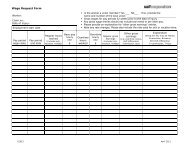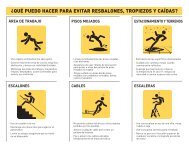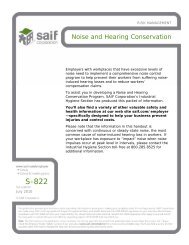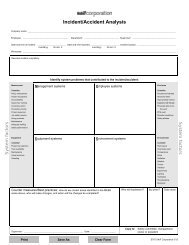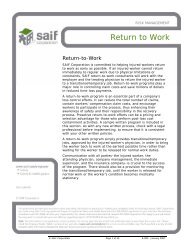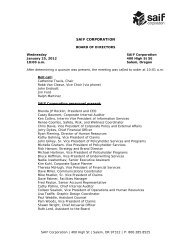Excavation, Trenching and Shoring Operations - SAIF Corporation
Excavation, Trenching and Shoring Operations - SAIF Corporation
Excavation, Trenching and Shoring Operations - SAIF Corporation
You also want an ePaper? Increase the reach of your titles
YUMPU automatically turns print PDFs into web optimized ePapers that Google loves.
SC-116<br />
June 2007<br />
Risk Management – Safety Challenges<br />
www.saif.com<br />
<strong>Excavation</strong>, <strong>Trenching</strong> <strong>and</strong> <strong>Shoring</strong><br />
<strong>Operations</strong><br />
The Dynamics <strong>and</strong> Dangers of<br />
Working with Dirt<br />
© <strong>SAIF</strong> <strong>Corporation</strong>, Risk Management — Safety Challenges SC-116, June 2007<br />
RISK MANAGEMENT<br />
Safety Challenges<br />
Trench <strong>and</strong> excavation cave-ins account for a growing<br />
number of fatalities <strong>and</strong> serious injuries in construction.<br />
Too many contractors <strong>and</strong> their employees fail to realize<br />
the hazard of working in unprotected or poorly protected<br />
excavations. With little or no warning, an unsupported,<br />
improperly shored or sloped trench or excavation wall can<br />
collapse, trapping the workers in seconds.<br />
Common causes of trench <strong>and</strong> excavation cave-ins<br />
include:<br />
• inadequate shoring in an attempt to cut costs or<br />
save time<br />
• misjudgment of soil conditions<br />
• defective shoring materials<br />
• failure to evaluate changing weather conditions<br />
• heavy loads in the area.
<strong>Excavation</strong>s<br />
Risk Management – Safety Challenges<br />
www.saif.com<br />
Extreme caution must be used during any excavation. A trench is referred to as a<br />
narrow excavation in which the depth is greater than the width, <strong>and</strong> the width is<br />
not greater than 15 feet. An excavation is any man-made cavity or depression in<br />
the earth’s surface. This can include excavations for anything from basements to<br />
highways.<br />
All excavations over four-feet deep (Washington), or five-feet deep (Oregon), must<br />
be sloped, shored, sheeted, braced or otherwise supported. When soil conditions<br />
are unstable, excavations shallower than four feet must also be sloped, supported<br />
or shored.<br />
Sitework <strong>and</strong> Building <strong>Excavation</strong><br />
Site excavation involves factors beyond merely “digging a hole” for even relatively<br />
small buildings. Proper preparation for the site can be as involved as the erection<br />
<strong>and</strong> completion of the building itself.<br />
Core borings taken at an appropriate number of locations will disclose the presence<br />
of one or more of the following:<br />
1. Rock<br />
2. Water<br />
3. S<strong>and</strong> - including quicks<strong>and</strong><br />
© <strong>SAIF</strong> <strong>Corporation</strong>, Risk Management — Safety Challenges SC-116, June 2007
Risk Management – Safety Challenges<br />
www.saif.com<br />
These are conditions for which allowance must be made in site work <strong>and</strong><br />
excavation. Study all site plans <strong>and</strong> contact all known utility services to determine if<br />
there are any:<br />
1. Telephone cables<br />
2. Electric power cables<br />
3. Water lines (in-service or ab<strong>and</strong>oned)<br />
4. Sewer lines (in-service or ab<strong>and</strong>oned)<br />
5. Tunnels (new, in-service or ab<strong>and</strong>oned)<br />
If any of these underground sources are identified, hold an immediate consultation<br />
with the utility companies involved. Any damage to existing utilities during sitework<br />
<strong>and</strong> excavation will add significant expenses to the project.<br />
Safe <strong>Trenching</strong><br />
The first step in safe trenching <strong>and</strong> excavation work begins in the pre-bid stage<br />
when you should make allowances in both time <strong>and</strong> cost for applying safe shoring<br />
<strong>and</strong>/or sloping systems. Correcting mistakes in shoring <strong>and</strong>/or sloping after work<br />
has begun slows down the operation, adds to the cost <strong>and</strong> increases the possibility<br />
of an excavation failure.<br />
Use a checklist to establish pre-planning before the actual digging begins:<br />
• Choose a support system sturdy enough to withst<strong>and</strong> the pressure of<br />
the soil.<br />
• Choose a support system sturdy enough to withst<strong>and</strong> the stress which may<br />
be exerted by water, vibration, or heavy loads.<br />
• Properly support any underground installations that are uncovered.<br />
© <strong>SAIF</strong> <strong>Corporation</strong>, Risk Management — Safety Challenges SC-116, June 2007
Risk Management – Safety Challenges<br />
www.saif.com<br />
• Locate any underground installations - sewer, telephone, water, fuel <strong>and</strong><br />
electric lines that may be encountered in the digging.<br />
• Contact the utility companies involved <strong>and</strong> inform them of the proposed work<br />
before starting the trench or excavation.<br />
Sloping for Safety<br />
One method of ensuring the safety <strong>and</strong> health of workers in a trench or excavation<br />
is to slope the sides of the cut to the “angle of repose,” the angle closest to the<br />
perpendicular at which the soil will remain at rest. The angle of repose varies with<br />
different kinds of soil <strong>and</strong> must be determined on each individual project. When an<br />
excavation has water conditions, silty material or loose boulders, or when it is being<br />
dug in areas where erosion, deep frost, or slide planes are apparent, the angle of<br />
repose must be flattened.<br />
A second method of support is shoring (sheeting, tightly placed timber shores,<br />
bracing, trench jacks, piles, or other materials) installed in a manner strong enough<br />
to resist the pressures surrounding the excavations.<br />
You should also consider the use of a trench box. A trench box is a prefabricated<br />
movable trench shield composed of steel plates welded to a heavy steel frame. Use<br />
a trench box if the protection it provides is equal to or greater than the protection<br />
that would be provided by the appropriate shoring system.<br />
<strong>Trenching</strong> Procedures<br />
<strong>Trenching</strong> operations are hazardous even under the best of conditions <strong>and</strong> a<br />
thorough hazard analysis should be made prior to start up. The result of your<br />
hazard analysis should be previewed with all employees who may work near the<br />
trenching operation. If you are involved in trenching operations where the<br />
excavation is deeper than four feet, established procedures must be developed in<br />
accordance with all federal, state <strong>and</strong> company policies.<br />
Your written procedures should include the checklists provided at the end of<br />
this section.<br />
Support Systems<br />
Designing a support system can be a complex operation because of the number of<br />
factors involved. Some of the consideration you must take into account:<br />
• Soil structure<br />
• Depth of cut<br />
• Water content of soil<br />
• Changes due to weather <strong>and</strong> climate<br />
• Superimposed loads<br />
• Vibrations<br />
• Other operations in the vicinity<br />
© <strong>SAIF</strong> <strong>Corporation</strong>, Risk Management — Safety Challenges SC-116, June 2007
<strong>Shoring</strong><br />
Risk Management – Safety Challenges<br />
www.saif.com<br />
Whatever support system is used, workers should always apply shoring from the<br />
top of the trench or excavation <strong>and</strong> work down. In installing the shoring, care must<br />
be taken to place the crossbeams or trench jacks in true horizontal position <strong>and</strong> to<br />
space them vertically at appropriate intervals. The braces also must be secured to<br />
prevent sliding, falling, or kickouts.<br />
All materials used for shoring must be:<br />
• in good condition<br />
• free of defects<br />
• of the right size<br />
Timbers with large or loose knots should not be used.<br />
Installation<br />
Installing the shoring should immediately follow the excavation work. It is<br />
dangerous to allow trenches to remain unshored even if no work is being done in<br />
them: dirt walls will slough off, causing dangerous overhangs. The longer a trench<br />
is left unsupported, the greater the chance of a cave-in.<br />
Removal<br />
As soon as work is completed, the trench should be backfilled as the shoring is<br />
dismantled. After the trench has been cleared, workers should remove the shoring<br />
from the bottom up, taking care to release jacks or braces slowly. In unstable soil,<br />
ropes should be used to pull out the jacks or braces from above.<br />
Inspections<br />
<strong>Shoring</strong> systems must be inspected daily by a competent person. Inspections also<br />
are required after rainstorms or any changes in conditions that can increase the<br />
possibility of a cave-in or slide. If dangerous ground movements are apparent, such<br />
as subsidence or tension cracks, all work in the excavation must be stopped until<br />
the problem has been corrected.<br />
© <strong>SAIF</strong> <strong>Corporation</strong>, Risk Management — Safety Challenges SC-116, June 2007
Risk Management – Safety Challenges<br />
www.saif.com<br />
In case of an emergency, workers must be able to leave the trench quickly. When<br />
employees are required to be in trenches four feet deep or more, adequate means<br />
of exit, such as a ladder or steps, shall be provided <strong>and</strong> located so as to require no<br />
more than 25 feet of lateral travel.<br />
<strong>Trenching</strong> <strong>and</strong> excavation work leaves no room for risk-taking <strong>and</strong> requires that<br />
safe working conditions be provided for all employees working in excavations.<br />
The supervisor who designs the protection <strong>and</strong> the employee(s) who install it can<br />
help create a greater awareness of the safety problems to help end cave-in hazards<br />
in construction.<br />
Other Conditions to Consider<br />
The soil structure must be carefully identified. <strong>Excavation</strong>s in wet soil, s<strong>and</strong>y soil, or<br />
areas that have been backfilled are relatively unstable <strong>and</strong> must have strong<br />
support. Even hard rock sometimes can be hazardous; faults in the strata can make<br />
it unstable when cut.<br />
Unstable Conditions<br />
Sometimes you will have to guard against an unstable excavation bottom, such as<br />
below the water line. Sheeting may have to be driven below the bottom of such an<br />
excavation to add to the soil stability.<br />
Diversion dikes <strong>and</strong> ditches or other suitable means must be used to prevent<br />
surface water from entering an excavation <strong>and</strong> to provide adequate drainage of the<br />
area adjacent to the excavation. Water causes soil erosion <strong>and</strong> softening <strong>and</strong> should<br />
not be allowed to accumulate in a trench or excavation.<br />
<strong>Shoring</strong> for large excavations should provide long-range protections from a variety<br />
of weather conditions. In some cases, additional precautions are necessary to<br />
protect excavation walls, such as covering them with plastic sheeting or spraying<br />
the soil bank with a moisture-limiting chemical.<br />
Superimposed loads in the vicinity of a trench or excavation increase the pressure<br />
on excavation walls. Heavy equipment <strong>and</strong> materials such as pipes or timbers<br />
should be kept as far back from the excavation as possible.<br />
Buildings, curbs, trees, utility poles, <strong>and</strong> other structures adjoining the excavation<br />
area also can place more stress on a trench side than it can safely accommodate. In<br />
these instances, bracing, or underpinning must be provided as necessary not only<br />
to protect workers but also to prevent the dislocation of the soil beneath the<br />
structures in the vicinity.<br />
Spoils or excavation material can exert great pressure on the excavation walls.<br />
Spoils must be stored at a distance equal to the depth of the excavation, <strong>and</strong> be<br />
barricaded or retained in an effective manner.<br />
Vibrations or sudden shock from passing vehicles or railways, blasting, equipment<br />
such as trucks or pile drivers, <strong>and</strong> some tools can contribute to cave-ins by<br />
loosening the soil. Even machines operated in nearby buildings, such as punch<br />
© <strong>SAIF</strong> <strong>Corporation</strong>, Risk Management — Safety Challenges SC-116, June 2007
Risk Management – Safety Challenges<br />
www.saif.com<br />
presses, can create enough vibrations to endanger a shoring system. If these<br />
conditions exist near an excavation site, stronger support is vital.<br />
General <strong>Trenching</strong> <strong>Operations</strong> Checklist<br />
1. Before trenching or excavation, check the following:<br />
• Soil Conditions or other material<br />
to be due.<br />
• Proximity to utilities, buildings<br />
<strong>and</strong> sources of vibrations.<br />
• Owners of utilities, service, or<br />
transmission piping, etc., <strong>and</strong><br />
arrange for shutdown or<br />
relocation<br />
of facilities, if necessary.<br />
• For previously distributed<br />
ground.<br />
• For trees, boulders, or other<br />
hazards.<br />
• Adequacy <strong>and</strong> availability of all<br />
equipment, including personal<br />
protective gear, shoring<br />
materials, signs, barricades,<br />
<strong>and</strong> machinery.<br />
2. During trenching or excavation, regularly check for:<br />
• Changing ground conditions;<br />
particularly after rainfall.<br />
• Possible oxygen deficiency or<br />
gaseous conditions.<br />
• Adequacy of shoring <strong>and</strong>/or<br />
sloping as work progresses.<br />
• Maintenance of entrance <strong>and</strong><br />
exit facilities.<br />
• All sheeting, bracing, shoring<br />
<strong>and</strong> underpinning.<br />
• Changes in vehicular <strong>and</strong><br />
machinery operational patterns.<br />
Notes: __________________________<br />
Notes: __________________________<br />
Notes: __________________________<br />
Notes: __________________________<br />
Notes: __________________________<br />
Notes: __________________________<br />
Notes: ________________________<br />
Notes: ________________________<br />
Notes: ________________________<br />
Notes: ________________________<br />
Notes: ________________________<br />
Notes: ________________________<br />
© <strong>SAIF</strong> <strong>Corporation</strong>, Risk Management — Safety Challenges SC-116, June 2007
3. After trenching or excavation, check the following:<br />
• Depth of trenching or<br />
excavation,<br />
its sloping <strong>and</strong> shoring.<br />
• Sloping of banks, sides <strong>and</strong><br />
walls in relation to depth of<br />
cut, water content of soil,<br />
vibrations.<br />
• Entrance <strong>and</strong> exit facilities.<br />
• Location of heavy equipment -<br />
power shovels, derrick, trucks.<br />
• <strong>Excavation</strong> material is two<br />
feet or more from edge of<br />
opening.<br />
• Portable trench boxes or trench<br />
shields are adequate, if used.<br />
• Cross braces or trench jacks are<br />
correctly positioned to prevent<br />
sliding falling or kickouts.<br />
Risk Management – Safety Challenges<br />
www.saif.com<br />
Notes: ________________________<br />
Notes: ________________________<br />
Notes: ________________________<br />
Notes: ________________________<br />
Notes: ________________________<br />
Notes: ________________________<br />
Notes: ________________________<br />
© <strong>SAIF</strong> <strong>Corporation</strong>, Risk Management — Safety Challenges SC-116, June 2007
Risk Management – Safety Challenges<br />
www.saif.com<br />
Underground <strong>Excavation</strong> <strong>and</strong> <strong>Trenching</strong> Procedures<br />
• Submit a detailed drawing of the proposed excavation route to the<br />
superintendent, project foreman, construction manager or general contractor<br />
prior to the start of excavation. The drawing should include areas outside the<br />
site fence line <strong>and</strong> in the parking lot.<br />
• The superintendent or designated authority will review <strong>and</strong> locate all<br />
underground utilities on your proposed drawing, make final approval <strong>and</strong><br />
sign off.<br />
• Any changes in excavation routing must be approved <strong>and</strong> signed off by the<br />
superintendent or designated authority prior to beginning work.<br />
• A copy of the approved drawing must be reviewed by <strong>and</strong> held in the<br />
possession of the operator actually performing the work.<br />
• Once the excavation <strong>and</strong> installation is complete, each contractor must<br />
submit to the general contractor an as-built drawing locating all newly<br />
installed piping <strong>and</strong> utilities.<br />
• The general contractor will then update the original drawing locating all<br />
newly installed underground piping <strong>and</strong> utilities on jobsite.<br />
© <strong>SAIF</strong> <strong>Corporation</strong>, Risk Management — Safety Challenges SC-116, June 2007
Pre-<strong>Excavation</strong> Requirements Checklist<br />
Risk Management – Safety Challenges<br />
www.saif.com<br />
• Prior to opening <strong>and</strong> excavation, effort shall be made to determine whether<br />
underground installations such as sewer, telephone, water, fuel, electric<br />
lines, etc. are present, <strong>and</strong> where they are actually located.<br />
• The walls <strong>and</strong> faces of all excavations in which employees are exposed to<br />
danger from moving ground shall be guarded by a shoring system, sloping of<br />
the ground or some other equivalent means.<br />
• The determination of the angle of repose <strong>and</strong> design of the supporting<br />
system shall be based on careful evaluation of pertinent factors such as:<br />
depth of cut, possible variation in the water content of the materials from<br />
exposure to air, sun, water or freezing.<br />
• All slopes shall be excavated to at least the angle of repose except for areas<br />
where solid rock allows for line drilling or presplitting.<br />
• The angle of repose shall be flattened when an excavation has water<br />
conditions, silty materials, loose boulders, <strong>and</strong> areas where erosion, deep<br />
frost action <strong>and</strong> slide planes appear.<br />
• In excavations which employees may be required to enter, excavated or<br />
other materials shall be effectively stored <strong>and</strong> retained at least 2 feet or<br />
more from the edge of the excavation.<br />
• Banks more than 4 feet high (Washington), 5 feet high (Oregon), shall be<br />
shored, laid back to a stable slope or some other equivalent means of<br />
protections shall be provided.<br />
• When employees are required to be in trenches 4 feet deep or more, an<br />
adequate means of exit, such as a ladder or steps, shall be provided <strong>and</strong><br />
located so as to require no more than 25 feet of lateral travel.<br />
© <strong>SAIF</strong> <strong>Corporation</strong>, Risk Management — Safety Challenges SC-116, June 2007
<strong>Excavation</strong> Inspection Checklist<br />
Risk Management – Safety Challenges<br />
www.saif.com<br />
• Daily inspections of excavations <strong>and</strong> trenches shall be made by the<br />
Competent Person. If evidence of possible cave-ins or slides is apparent, all<br />
work in the excavation or trench shall cease until the necessary precautions<br />
have been taken to safeguard the employee. In addition, all open trenches<br />
require high visibility perimeter flagging.<br />
• All excavation <strong>and</strong> trenches shall be inspected by the Competent Person after<br />
every rainstorm or other hazard-increasing occurrence <strong>and</strong> the protection<br />
against slides <strong>and</strong> cave-ins shall be increased, if necessary.<br />
• Figures 1 <strong>and</strong> 2 shall be used as guides for reference to angle of repose <strong>and</strong><br />
shoring techniques used in excavations <strong>and</strong> trenches. These tables show the<br />
minimum requirements; added measurements must be taken if the<br />
conditions warrant added protection to avoid slides <strong>and</strong> cave-ins.<br />
© <strong>SAIF</strong> <strong>Corporation</strong>, Risk Management — Safety Challenges SC-116, June 2007
A Competent Person Must:<br />
1. Be able to recognize hazards.<br />
2. Have authority to stop work <strong>and</strong> correct hazards.<br />
3. Be knowledgeable of the st<strong>and</strong>ards that apply.<br />
4. Be able to recognize or train qualified workers.<br />
Risk Management – Safety Challenges<br />
www.saif.com<br />
After trenching or excavation, be sure to check the following:<br />
• Depth of trenching or excavation, its sloping <strong>and</strong> shoring.<br />
• Sloping of banks, sides <strong>and</strong> walls in relation to depth<br />
of cut, water content of soil, vibrations.<br />
• Entrance <strong>and</strong> exit facilities.<br />
• Location of heavy equipment - power shovels, derricks, trucks.<br />
• Excavated materials are two feet from the edge of opening.<br />
• Adequacy of portable trench boxes or trench shields, if used.<br />
• Correct positioning of cross braces or trench jacks to<br />
prevent sliding, falling, or kickouts.<br />
<strong>Excavation</strong> <strong>and</strong> trenching requirements:<br />
• All trenches 4 feet or more in depth (Washington), or 5 feet or more<br />
(Oregon), must be shored, sloped or protected by a trench box.<br />
• All material must be at least two feet from the edge of excavation.<br />
• Access ladders must be provided every 25 feet in all trenches 4 or more feet<br />
(Washington) or 5 or more feet (Oregon) in depth.<br />
© <strong>SAIF</strong> <strong>Corporation</strong>, Risk Management — Safety Challenges SC-116, June 2007


